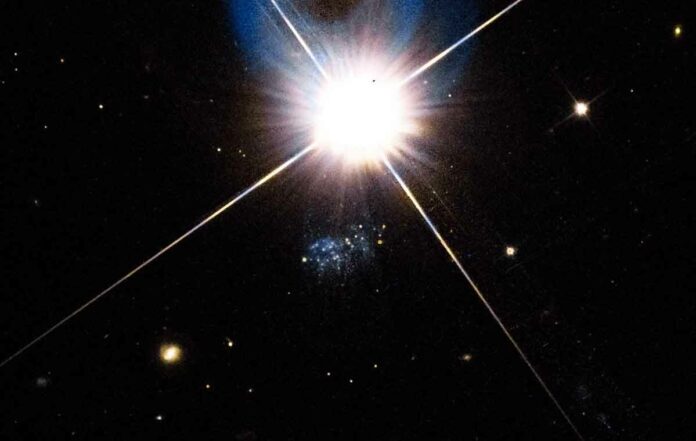Scientists have used the Southern African Large Telescope (SALT) and the Hubble Space Telescope (HST) and observed the dwarf galaxy HIPASS J1131-31. The galaxy is dubbed as the “Peekabo Galaxy.” The observational campaign discovered that Peekabo is one of the most metal-poor galaxies ever discovered. The discovery was reported in a paper published in the Royal Astronomical Society’s Monthly Notices.
Peekabo is a nearby dwarf irregular galaxy 21.8 million light years away from Earth. It was discovered in 2001 as it emerged from behind a bright fast-moving star known as TYC 7215-199-1. Previous observations of this galaxy were difficult to make due to the glare of TYC 7215-199-1. But the new study suggested that it is a young system with low chemical enrichment.
A group of astronomers led by Igor D. Karachentsev of Russia’s Special Astrophysical Observatory (SAO) investigated Peekabo with SALT and HST. They wanted to learn more about the galaxy’s properties and chemical composition. Astronomers also used archival data from the Australia Telescope Compact Array (ATCA).
According to optical spectral observations, Peekaboo is a gas-rich dwarf galaxy with neutral atomic hydrogen. Peekaboo was discovered to be one of the most metal-poor galaxies known.
Peekaboo has an absolute magnitude of 11.27 mag, a half-light radius of about 391 light-years, and a central surface brightness of 22.0 mag/arcsec2. The galaxy’s distance was calculated to be approximately 22.2 million light years.
Peekaboo is thought to be a member of the scattered association of late-type dwarf galaxies that surrounds the galaxy NGC 3621. This group is situated between the Local Sheet and the Dorado-Leo Spur-Antlia mini-wall.
The study also discovered that Peekaboo has a low number of red giant branch (RGB) stars. The discovery implies that star formation in this galaxy began within the last few billion years. It implies that the system is devoid of ancient stellar populations.
More information: I D Karachentsev et al, Peekaboo: the extremely metal poor dwarf galaxy HIPASS J1131-31, Monthly Notices of the Royal Astronomical Society (2022). DOI: 10.1093/mnras/stac3284

